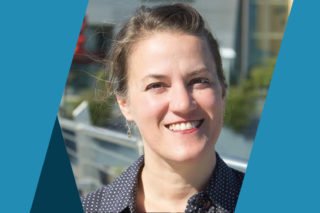Finding Freedom in Freelance Work: Julie Rea’s Job Search Story

Share
Everyone’s job search story is different, but each individual story can inspire and empower others who are on their own unique path. Julie Rea started her design career in a traditional 9-5 job before transitioning into full-time freelance work. Here’s Julie’s story.
What do you do for a career? Who do you work for?
I’m a freelance graphic designer. My client list includes the cities of West Linn and Milwaukie, social justice nonprofits, and small start-up, women-owned businesses.
How long did it take you to find this occupation?
As they say “it’s complicated!” I believe freelancing found me rather than me finding freelancing. I was the art director and graphic designer for a local ad agency for a few years before I was laid off during the 2002 recession.
I immediately began freelancing for my former employer while looking for full time employment, since I wasn’t sure what else to do or how to go about doing it. After a year of freelancing for a handful of clients, I took a job at the Oregonian so I could pay the bills but continued to freelance. After three years of doing this, I realized I preferred unconventional employment. So I quit in 2006 and officially began working for myself full-time. Long story short, it took me about seven years to completely transition into a full time freelance career.
How did you come to your current role? What resources did you use? What tool or tactic helped the most?
Sheer perseverance during many years of trials & tribulations! It took me a while to figure out how to become a successful self-employed graphic designer in Portland–a mecca for creatives.
I had yet to find my proverbial “dream job” working in traditional 9-5 environments. (I was looking for a mix of designing book layouts, branding and food packaging, along with the ability to take frequent breaks for gardening, walking breaks, and playing with my kids.) So I decided to create my own dream job as a freelancer. I am so happy I did!
While I was getting started as a freelance, one of the most useful resources was the career advising center at my alma mater, Pacific Northwest College of Art. This was how I landed my first design job. Getting my first gig was a crucial threshold, which made it easier to land my next job. I’ve found that each job is a stepping stone to the next opportunity.
The other tactic that has been invaluable is networking. This is true, even though I’m an introvert! I go to events, call upon current clients, and alert friends and family that I’m looking for creative gigs. It’s hard to not let the onslaught of “nos” get you down but when you start getting the “yeses,” it’s all the sweeter.
What was the most difficult part of your job search? How did you overcome this challenge?
Hands-down, the most difficult part of freelancing has been finding clients. I overcome this challenge by being the best designer my clients have ever worked with. So not only do they become repeat clients but they also become my best sources for referrals as well. It’s a win-win!
It also helps if you know who your ideal clients are and what your niche speciality is. It’s okay to focus on your strengths and interests, rather than be a one-size-fits all designer.
For example, I’ve learned that I don’t enjoy doing websites. I’ve tried to love website design but I feel much more successful designing food packaging, identity brands, and publication layouts. I’d also love to design a cookbook some day.
What is the single best piece of advice you would offer other job-seekers?
Begin by finding your tribe of other freelance creatives, if you don’t have one already. Make sure you nurture these relationships.
Freelancing is a tricky and fickle business and you’ll have many questions in the beginning. This is especially true when you realize that there are taxes to pay, licenses to obtain, agreements to read, etcetera. To help you figure this stuff out, I suggest talking with established freelancers in your field. You can glean all sorts of wisdom from people who have already made a similar career journey.
One way to start is to seek out designers whose work you admire and offer to take them out for coffee to talk shop. Designers rarely get the kudos they deserve so, when we are noticed, it can really make our day!
And if you are one of the lucky ones who already has found your tribe, invite others to join! Being a freelancer can be a lonely occupation but it need not be, especially as Portland has so many wonderful networking opportunities.
Why do you love your job?
So many reasons! Some are selfish; some are altruistic. I am my own boss which means I get to choose when and how much I work, which clients I want to take on, and how much money I make. It’s always been important to me to believe in the projects I’m working on. For the past five years, I’ve worked with social justice nonprofits designing communication and outreach materials. And most recently, I’ve been working at a highly reduced rate for other women business owners who are just starting out and needing branding design.
I also love graphic design and being able to make a difference with my designs. Graphic design, when done well, is a powerful way to communicate a message to the masses. I’m thankful to be a part of so many wonderful organizations, and to help them to communicate their brand.
Connect with Julie on LinkedIn, Instagram, or her company website.